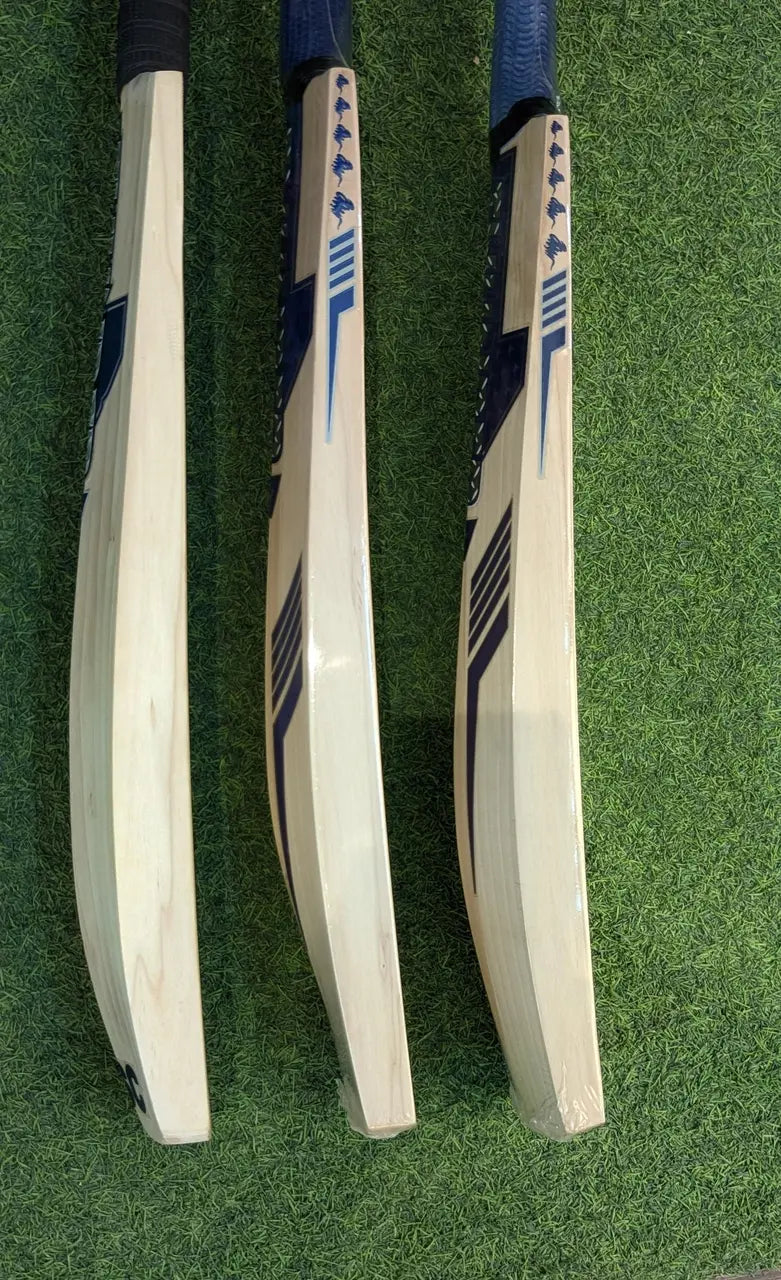Choosing the right cricket bat is the most crucial aspect for optimizing your performance. The profile of a cricket bat should align with your playing style, especially when considering factors such as pitch conditions and personal strengths. Understanding how bat profiles cater to various playing styles is crucial for every cricketer looking to optimize their game.
Understanding Cricket Bat Profiles
Cricket bat profiles encompass a variety of designs that cater to different playing styles. Some unique profiles of the JF Thunder Cricket Bat by Tornado Sports Company (TSC) in the image above is an excellent example of this. Each profile has specific features that can enhance a player’s performance depending on their individual techniques. For instance, players who favor aggressive front-foot play may opt for a bat that possesses a lower sweet spot, while those who play more backfoot oriented shots may seek a higher sweet spot for better elevation. The understanding of these profiles can be the difference between a successful innings and an unnecessary dismissal.
Beyond personal preference, the choice of bat profile also factors in external conditions, such as the type of pitch being played on. For example, a player who often engages with bouncy Australian pitches may find that a bat with a higher sweet spot serves them well. Conversely, on slower pitches, such as those commonly found in Asia, a different profile might be required to master the low bounce that characterizes such conditions.
In summary, understanding cricket bat profiles is paramount for every player aiming to refine their game. Whether it’s learning about the low sweet spot or recognizing when thicker edges and toes are beneficial, knowledge in this area leads to better decision-making in selecting one’s equipment.
The Impact of Pitch Conditions on Bat Choice
Pitch conditions play a crucial role in determining the appropriate cricket bat profile. When facing a low bounce on Asian pitches, it becomes imperative for batsmen to reconsider the bat profile they use. Low-bounce pitches can often catch cricketers off guard, leading to mishits and easy dismissals. A bat with a lower sweet spot is typically preferred in these scenarios, as it provides the necessary leverage to connect with the ball effectively when it skids off the surface.
Furthermore, pitch conditions dictate more than just the height of the sweet spot; they influence the bat’s weight and balance as well. On slower pitches, a slightly heavier bat can provide cricketers with the momentum they need to strike the ball with conviction. This is particularly important in Asian countries where spinners thrive, and a strong front-foot game is essential to tackle their variations. Thus, adapting to pitch conditions requires a thoughtful approach towards bat selection.
In conclusion, understanding how pitch conditions influence bat choice is vital for players. Those who manage to align their bat profiles with these conditions often find themselves performing with greater consistency and confidence.
Low Bounce on Asian Pitches: The Need for a Specialized Profile
Asian pitches are notorious for their low bounce, making them a challenging environment for many cricketers. This characteristic significantly influences the choice of bat profile. Opting for a bat with a lower sweet spot is essential for adapting to these slower surfaces. When the ball doesn’t rise as expected, players need to ensure their equipment supports their technique. A bat designed for this playing condition allows batsmen to maintain accuracy and power, even in unfavorable scenarios.
In addition to the sweet spot, having thicker edges and toes on a bat can also be advantageous in such conditions. These features can enhance the durability and performance of the bat while offering better control when timing is off. As players contend with the unpredictable behavior of a low bounce, these attributes become invaluable, giving them the confidence to attack the ball aggressively without fear of being caught out.
Moreover, using a specialized bat for low bounce conditions allows players to experiment with shots that may be risky on a bouncier pitch. Players can initiate their shots earlier and play with a more aggressive mindset, qualities that can lead to establishing strong partnerships and scoring rates even on challenging surfaces.
Choosing a Low Sweet Spot for Front Foot Oriented Gameplay
For cricketers who prefer a front foot-oriented gameplay style, a bat with a low sweet spot can significantly enhance performance. This type of bat is engineered to help players meet the ball with greater balance and power, providing the leverage they need to play confident shots. The low sweet spot is exceptionally useful when executing drives and lofted shots, particularly when the bowler presents a good length delivery that can be attacked.
The synergy between a low sweet spot and front-foot play is pivotal in maximizing scoring opportunities. Players who find their strength in dominating bowlers in the early overs should prioritize this bat profile. The lower center of gravity empowers them to make better use of their weight transfer, ensuring crisp connections even on varying surfaces. With a bat that complements their natural flair, cricketers can truly shine.
In essence, the choice of a low sweet spot bat is not just about the technical specifications; it also encapsulates a player’s style and preference. For those who thrive on aggression and front-foot dominance, this profile can be a game-changer.
The Advantages of Thicker Edges and Thicker Toes
Thicker edges and thicker toes on a cricket bat present numerous advantages, particularly for players who need robust equipment to battle challenging conditions. These features provide an improved sweet spot and greater resilience, ensuring that the bat performs well even after prolonged use. Many cricketers face the problem of diminishing returns from their equipment over time, which can be exacerbated on surfaces that offer little bounce. A bat with these enhancements can help mitigate such issues.
Additionally, the thicker design can offer a sense of security to players. The increased mass at the edges translates into an ability to play expansive shots without the fear of being easily outed. When facing spinners or divide bowlers, having a thicker-edged bat can boost confidence, allowing players to explore aggressive stroke play regardless of the pitch type.
Ultimately, the decision to utilize thicker edges and toes should not just be a matter of trend but one of necessity based on playing conditions and style. For those looking to adapt to low bounce conditions found typically on certain Asian pitches, a thicker bat can be a powerful ally.
Personalizing Your Bat: Finding the Right Fit for Your Playing Style
Personalization in cricket bat selection is a crucial yet often overlooked aspect of enhancing performance. Tailoring a bat to suit individual playing styles can elevate a player’s game from standard to exceptional. This personalization extends beyond mere aesthetics or brand preferences; it is about honing in on specifications that align with one’s unique approach to batting, from bat weight to profile design.
Every player has distinct strengths and weaknesses, and their batting style reflects that individuality. For instance, a player who excels at back-foot shots may prefer a bat with a more traditional profile, while a front-foot player would ideally seek features like a low sweet spot and perhaps a heavier weight. Realizing such preferences is part of the art and science of cricket mastering.
Furthermore, the integration of advanced technology in bat manufacturing allows for customization that was previously unattainable. Players can opt for specific weights, balance points, and shapes that cater directly to their playing requirements. With access to such options, cricketers are given the tools to push their limits and redefine their performance. Selecting the appropriate bat profile becomes not just an equipment choice, but a journey towards mastering the game.
Final Thoughts on Bat Profile Selection
Selecting the appropriate cricket bat profile can significantly influence your performance, especially in challenging conditions like low-bounce Asian pitches. By understanding your playing style and the attributes of different bat profiles, you can make a more informed decision, ultimately leading to improved gameplay.



